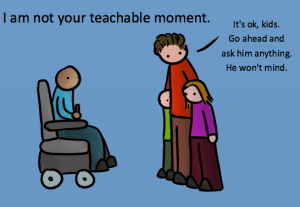
Source: Showtime
So you’ve been reading about polyamory and have decided it’s something you want to try. Or maybe you’re still thinking about it, but don’t have a clear sense of where you’d even begin.
Here are a few tips, guidelines, and things to consider for people just starting out in the polyamorous world.
Questions to Ask Yourself
Partly because it’s outside of our cultural norm, and partly because it involves coordinating the needs and preferences of so many people, being happily polyamorous pretty much requires the ability to reflect on what you want and communicate it with your partners.
Whether you’re starting out solo or opening up an existing relationship, these are some questions that will be very helpful to ponder at the beginning of your polyam journey.
1. Why Do I Want This?
What great things are you expecting polyamory to bring to your life? More sex? Someone to go with you to movies that your partner hates? A warm, loving community of friends and lovers?
There are lots of good reasons to get into polyamory, and making it clear to yourself which things are most important to you will help guide your decisions.
If you’re opening up an existing relationship, it’s good for you to know what your partner is hoping to gain and vice versa.
Articulating why you want to be polyamorous will also help you navigate the times when it’s tough: You can look back at your goals and assess whether you’re moving toward them overall and whether working through the hard stuff is still worth it.
2. What Would an Ideal Situation Look Like?
This will likely change with time, experience, and the people you meet, but it’s still good to set a baseline expectation.
Does the idea of a big house with five or six adults sharing love, sex, and household responsibilities sound awesome or alarming? Would you like to have a lot of partners that you see occasionally, or just two or three that you focus on? How much time a week do you want to spend on dates, whether with new people or established partners? Would you prefer to be friends with your partners’ partners, or keep relationships separate?
Whatever feels ideal for you is great. And knowing your own expectations and boundaries can help you work through finding partners who share your needs.
3. What Are My Insecurities and Fears?
Seeing a partner enjoy a loving relationship with someone else has the potential to bring all of your insecurities to the forefront, so it’s helpful to get in some work on addressing them ahead of time.
Some people get anxious about being abandoned by a partner, while others are more afraid of being taken for granted or always being in second place. And some of us have issues around our bodies or our sexual abilities.
Whatever your personal buttons are, polyamory will almost certainly push them.
It’s scary and often painful, but it can be great in the long run.
There’s something profoundly reassuring about finding out that your partner still wants to be with you, even when they’ve gotten to experience the great things another person has to offer.
4. How Will I Handle Jealousy?
You will get jealous at some point. That’s pretty inevitable, and it doesn’t mean you’re bad at polyamory or immature.
The key with jealousy is not avoiding it, but dealing with it when it arrives.
There are lots of great resources out there with advice and wisdom on dealing with jealousy. Read them ahead of time, and keep the most helpful ones on hand for when the green-eyed monster rears its head.
5. What Are My Boundaries Around STIs and Protection?
Part of responsible non-monogamy is thinking about safer sex and protecting your partners as well as yourself.
The vast majority of the polyam community are strict about using condoms for intercourse with new partners, at the very least. Beyond that, it’s a matter of personal comfort.
Do you want to use condoms and dental dams for oral sex? How often will you get tested for STIs? Where do you need to be in a relationship before you’d consider stopping using condoms?
Just like it’s important to discuss birth control and STI protection in monogamous relationships, it’s also important to talk about it in polyamorous relationships. So make sure to make it a priority!
6. How Will We Handle Dates and Scheduling?
If you’re single, you can play this one by ear, but if you’re opening up a relationship, you’ll want to set expectations about logistics.
Will you consult with each other before making a date, or just inform each other once you’ve made arrangements? Do you need to make sure the other partner has a date or friend to hang out with when one has a date? (It is often helpful to have some other activity to do rather than staying home alone when your partner has a date, especially at first.) Can you have dates over to the house if the other partner is home, and if so, how will you share the space?
Preventing problems before they arise is easier than intervening once they pop up, and making sure that you figure out logistics beforehand can really help in that endeavor.
How to Meet People
At some point in the process of becoming poly, most people have a moment where they look around and go, “Wait. How do I meet people, anyway?”
While polyamorous dating is just like single/monogamous dating in many ways, there are some key differences and things to consider.
A lot of polyamorous people use online dating services – a lot.
Meeting people online has the major advantage of enabling you to look specifically for people who are already poly, or open to it, and thus eliminating the major hassle of “How and when do I tell someone I’m polyamorous?”
OKCupid is overwhelmingly the most popular site for non-monogamous people, largely because has specific settings for non-monogamous relationships.
Another good way to meet people is to go to polyam meet ups (although see the point below about going to such things with the sole focus on finding a partner). Search around on social networking sites for polyam groups in your area, and see if they do a regular meetup somewhere. This is a great way to connect with a local community.
You can also meet people any of the ways one does when monogamous: bars, coffee shops, shared activity, and interest groups.
The catch there is that monogamy is the assumed default for relationships, so at some point you’ll have to tell the person you’ve been flirting with that you’re poly.
I recommend doing this as early as possible — putting it in with the other “get to know you” questions — to spare both of you the heartache of clicking really well with someone whose relationship style preferences are incompatible with yours.
Mistakes to Avoid
As with trying anything new, you’ll definitely make some mistakes, and that’s okay! But here are some common beginner mistakes to avoid.
1. Being a Dating Hound
A lot of people decide to be poly, connect with a community, and immediately start flirting with or asking out everyone they think is cute.
It’s understandable. Suddenly there are much fewer restrictions on who you can date, and you’re eager to start some relationships.
Take it easy.
First of all, people can tell when you’re looking to fill a spot in your life, rather than connecting particularly with them, and it’s often off-putting.
Second, by jumping immediately to “Who here can I make out with?” you’re taking the focus off building friendships. And building friendships with other polyamorous folk is helpful on multiple levels.
The friends you make will help you navigate the tough times and show you different models of how people actually do polyamory.
It’s fine (and natural!) to go to a polyam gathering hoping to meet a potential partner, but I recommend giving at least as much energy to making solid friendships and finding the people who will be your polyam support network.
2. Getting Swept Up in the NRE
New relationship energy, or NRE, is that feeling you get when you’re dating someone new and reeeally into them.
It’s the butterflies, the giddy joys and crushing anxieties, the “I can’t stop thinking about them and my friends are getting sick of hearing their name.”
It’s a common experience in any dating style, but polyamory creates the potential for a situation where you’re feeling all the rush and thrills of a new relationship while simultaneously maintaining an older, established relationship.
This can create stress and conflicting feelings all around.
When you’re in the throes of NRE, the impulse is to spend every waking minute with your new partner, to rush over to their house as soon as you hear they’re feeling sick, to shower them with love and attention at every opportunity.
If you already have a long-term partner, they may feel neglected or fear that you love the new person more. You yourself may feel confused: Maybe you love your long-term partner and can’t imagine life without them, but you can’t deny that the level of passion and excitement you’re feeling for the new person is just different.
NRE is a normal relationship stage, and it’s a fun one.
Growing out of it is also normal, whether that means falling out of love and letting a relationship dissolve, or developing a strong attachment bond which is steady and loving, but lacks the big highs and lows of the NRE phase.
Understanding this is key to dealing with NRE, whether you’re the one newly in love or the one watching your partner fall for someone else.
Everybody needs to find a balance between relishing the new feelings and making sure their existing partners don’t end up neglected.
With practice, a lot of polyam people have found ways to channel the energy from their new relationships into the longer-established ones, bringing a fresh surge of energy, tenderness, and excitement into relationships that have been going on for years.
3. Letting Fear Determine the Course of Your Relationships
Setting rules and boundaries is important, but it’s also important to make sure these are being set for the right reasons.
A lot of people, especially if they’re opening up an established relationship, worry about losing their partner, and they set up rules to make them feel safer.
But rules can’t protect a relationship. Only mutual commitment, respect, and compatibility can do that.
If you and your partner have a relationship that’s benefitting both of you, that you’re both giving sufficient time and attention to, that’s founded on mutual love, trust, and respect, then you don’t need rules to keep it safe.
If the relationship is already broken, if one of you is secretly looking for a way out, or ultimately you just aren’t a good match for each other, all rules will do is delay the inevitable and cause more heartbreak and fighting in the meantime.
***
Above all, stay flexible and be kind to yourself.
Polyamory brings a lot of changes and a lot of self-discovery.
There will be times when it’s hard and scary, and times when it’s exhilarating and life-giving. It can take some time to figure out how — or even if — polyamory works best in your life.
Embrace the process.
Ultimately, the goal is to deepen and strengthen your relationship with your #1 partner: yourself.
[do_widget id=”text-101″]
Want to discuss this further? Login to our online forum and start a post! If you’re not already registered as a forum user, please register first here.
Ginny Brown is a writer, speaker, and educator specializing in sexuality and relationships. She recently completed her M.Ed in Human Sexuality and teaches college courses in health and sexuality. She also writes at www.polyskeptic.com, a blog about polyamory, atheism, and culture. When not writing, thinking, and talking about sex and relationships, she’s most often found knitting and watching Dr. Who. Follow her on Twitter @lirelyn.
Search our 3000+ articles!
Read our articles about:
Our online racial justice training
Used by hundreds of universities, non-profits, and businesses.
Click to learn more




















